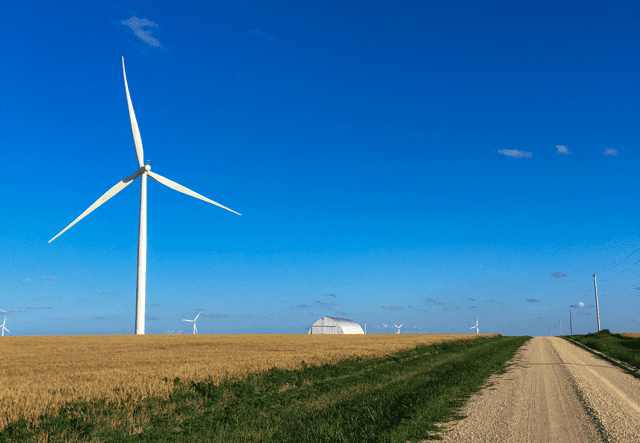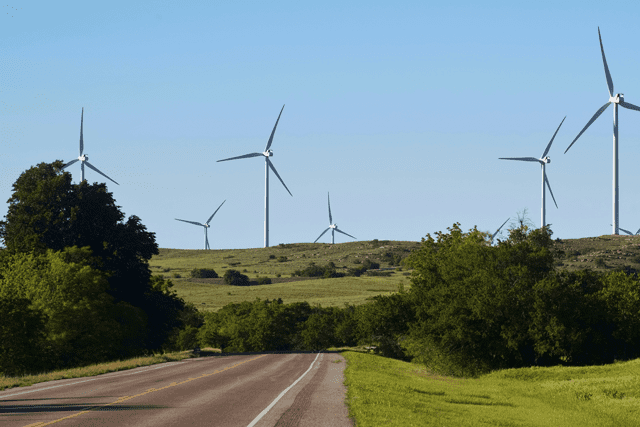
[dropcap]Oklahoma[/dropcap] has long been known for the wind that comes sweeping down the plains. The power of this wind has become an important part of the state’s energy supply and continues to evolve as it’s better utilized.
Giant turbines harness the energy of winds and generate power, which is transmitted to homes, businesses and other public entities.
Laura Fleet, the director of public policy for The Wind Coalition, says wind energy has benefited Oklahoma in a number of ways since it was first established in the early 2000s.
“It’s clean, cheap and infinite power that utilizes no water,” she says. “Oklahoma’s two largest utilities have estimated wind power that will save their customers over $2 billion over the lifetime of their wind purchase agreements.”
She adds that wind energy has had a positive impact on schools throughout the state.
“Wind power generates millions of dollars annually through ad valorem taxes for schools, which allow districts to invest in a myriad of capital improvements, salary increases for teachers and technology upgrades,” she says.
[pullquote]Wind energy is a science, and wind patterns are studied thoroughly before any development begins construction.”[/pullquote]County governments also receive revenue from wind energy, enabling them to provide an array of services for their respective residents.
In addition, the wind industry gives royalty payments to Oklahomans who lease their land for the placement of wind turbines.
“These royalty payments are a steady source of income, which allows many rural Oklahomans to maintain their farm and ranch operations,” Fleet says.
The towering wind turbines, some as tall as 212 feet and grouped in what are known as wind farms, can be spotted from miles away and certainly spark curiosity from passers-by. Fleet notes that there are more than 2,000 turbines in 19 of Oklahoma’s 77 counties. Blades reaching lengths of 116 feet catch the wind and spin the turbines, which send electrical currents through transmission lines to substations, where the electricity is dispersed.
According to the U.S. Department of Energy, Oklahoma is fourth in the nation with 5,453 megawatts of installed wind power capacity, trailing only Texas, Iowa and California. Approximately 18 percent of all electricity generated here comes from the wind, and Fleet says this percentage will increase as more businesses purchase renewable energy, especially larger corporations.
Locations for the turbines are carefully considered.
“Wind energy is a science, and wind patterns are studied thoroughly before any development begins construction,” Fleet says. “Wide, open, largely rural spaces, with fewer structures, are prime locations.”
She adds that, other than open land, there are a few other limitations to where wind turbines can be placed.
“The size of the turbines negates their placement in areas where there are structures,” Fleet says. “There are also setback restrictions requiring turbines to be placed a certain distance away from hospitals, schools and airports. Municipalities can also have setback ordinances.”
These limitations have proved to be challenging to the industry since the power that’s generated in open spaces has a quite long way to travel in order to reach more populated areas in the state.

This challenge is being addressed with a recently announced transmission line that will carry Oklahoma’s wind power to areas that it previously couldn’t reach, along with a row of other states. The Plains and Eastern Clean Line, a joint project of Clean Line Energy and GE Energy Connections, will stretch 720 miles and is the largest infrastructure project of its kind. The line is expected to provide 4,000 megawatts to more than 1 million homes in Arkansas, Tennessee, and other states in the Mid-South and Southeast. Construction has been approved and will begin in the second half of 2017.
Fleet says Oklahoma is looking ahead in the industry and, along with neighboring states, participates in the Southwest Power Pool, a regional transmission organization. It works with states, utilities and regulators to assess the area’s long- and near-term transmission needs.
“The benefits to planning ahead and building these farm-to-market wires, so to speak, are immense and help provide a strong electric grid, unlock customer savings and generate many economic benefits for a state like Oklahoma with abundant energy potential,” she says.
The coming years have a lot to hold for the wind industry.
“Like any emerging technology, the wind industry is constantly evolving,” Fleet says. “The industry is still very young in Oklahoma. In just over a decade, the industry has grown to be a respected and valued member of Oklahoma’s energy portfolio. New technologies are being developed and tested constantly and will only continue to improve the efficiency of wind power, which will provide continued low consumer electricity rates and reliable, clean, infinite energy to thousands of Oklahomans.”






















